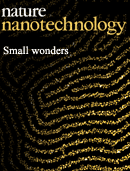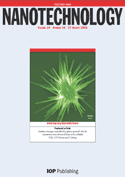
Nanotechnology is the manipulation of matter with at least one dimension sized from 1 to 100 nanometers (nm). At this scale, commonly known as the nanoscale, surface area and quantum mechanical effects become important in describing properties of matter. This definition of nanotechnology includes all types of research and technologies that deal with these special properties. It is common to see the plural form "nanotechnologies" as well as "nanoscale technologies" to refer to research and applications whose common trait is scale. An earlier understanding of nanotechnology referred to the particular technological goal of precisely manipulating atoms and molecules for fabricating macroscale products, now referred to as molecular nanotechnology.

A molecular assembler, as defined by K. Eric Drexler, is a "proposed device able to guide chemical reactions by positioning reactive molecules with atomic precision". A molecular assembler is a kind of molecular machine. Some biological molecules such as ribosomes fit this definition. This is because they receive instructions from messenger RNA and then assemble specific sequences of amino acids to construct protein molecules. However, the term "molecular assembler" usually refers to theoretical human-made devices.

King Abdulaziz City for Science and Technology in Riyadh, Saudi Arabia is a governmental organization established in 1977 as the Saudi Arabian National Center for Science & Technology (SANCST); in 1985, it was renamed King Abdulaziz City for Science and Technology.

The Journal of Physical Chemistry A is a scientific journal which reports research on the chemistry of molecules - including their dynamics, spectroscopy, kinetics, structure, bonding, and quantum chemistry. It is published weekly by the American Chemical Society.

Nature Nanotechnology is a monthly peer-reviewed scientific journal published by Nature Publishing Group. It was established in October 2006. The editor-in-chief is Alberto Moscatelli. It covers all aspects of nanoscience and nanotechnology.

Advanced Materials is a weekly peer-reviewed scientific journal covering materials science. It includes communications, reviews, and feature articles on topics in chemistry, physics, nanotechnology, ceramics, metallurgy, and biomaterials. According to the Journal Citation Reports, the journal has a 2022 impact factor of 29.4.
Because of the ongoing controversy on the implications of nanotechnology, there is significant debate concerning whether nanotechnology or nanotechnology-based products merit special government regulation. This mainly relates to when to assess new substances prior to their release into the market, community and environment.

Small is a weekly peer-reviewed scientific journal covering nanotechnology. It was established in 2005 as a monthly journal, switched to biweekly in 2009, and to weekly in 2015. It is published by Wiley-VCH and the editor-in-chief is José Oliveira. According to the Journal Citation Reports, the journal has a 2022 impact factor of 13.3.
IOP Publishing is the publishing company of the Institute of Physics. It provides publications through which scientific research is distributed worldwide, including journals, community websites, magazines, conference proceedings and books. The Institute of Physics is a scientific charity devoted to increasing the practice, understanding and application of physics. Any financial surplus earned by IOP Publishing goes to support physics through the activities of the Institute.

The Journal of Sol-Gel Science and Technology is a monthly peer-reviewed scientific journal covering research on sol-gel materials. Recent findings on new products developed via chemical nanotechnology are also included.

Biomedical Microdevices is a bimonthly peer-reviewed scientific journal covering applications of Bio-MEMS and biomedical nanotechnology. It is published by Springer Science+Business Media and the editor-in-chief are Alessandro Grattoni and Arum Han.

Iran has made considerable advances in science and technology through education and training, despite international sanctions in almost all aspects of research during the past 30 years. Iran's university population swelled from 100,000 in 1979 to 2 million in 2006. In recent years, the growth in Iran's scientific output is reported to be the fastest in the world.

Catalysis Science & Technology is a peer-reviewed scientific journal that is published monthly by the Royal Society of Chemistry. The editor-in-chief is Bert Weckhuysen.
SLAS Technology is a peer-reviewed scientific journal published by the Society for Laboratory Automation and Screening in partnership with Elsevier. The editor-in-chief is Edward Kai-Hua Chow, Ph.D.. The journal explores ways in which scientists adapt advancements in technology for scientific exploration and experimentation, especially in life sciences research and development. This includes drug-delivery; diagnostics; biomedical and molecular imaging; personalized and precision medicine; high-throughput and other laboratory automation technologies; micro/nanotechnologies; analytical, separation and quantitative techniques; synthetic chemistry and biology; informatics ; and more. The journal was published from 1996 through 2016 with the title Journal of Laboratory Automation. Its name changed in 2017 to more accurately reflect the evolution of its editorial scope.[1]
IEEE Life Sciences is an initiative launched by IEEE to promote the advancement of life sciences and supporting technologies, and to provide expertise and resources to individuals and enterprises involved in the various disciplines falling under the life sciences umbrella. IEEE Life Sciences provides access to a range of resources, including professional conferences, continuing education courses, publications, and standards. It is based in Piscataway, New Jersey.

Nanomedicine is a biweekly peer-reviewed medical journal covering research on medical nanoscale-structured material and devices, biotechnology devices and molecular machine systems, and nanorobotics applications in medicine. It was established in 2006 and is published by Future Medicine. The editors-in-chief are Kostas Kostarelos and Charles R. Martin.
Chennupati Jagadish, an Indian-Australian physicist and academic, is the President of the Australian Academy of Science, and a Distinguished Professor of Physics at the Australian National University Research School of Physics. He is head of the Semiconductor Optoelectronics and Nanotechnology Group which he established in 1990. He is also the Convener of the Australian Nanotechnology Network and Director of Australian National Fabrication Facility ACT Node.
The Beilstein Journal of Nanotechnology is a peer-reviewed platinum open-access scientific journal covering all aspects of nanoscience and nanotechnology. It is published by the Beilstein Institute for the Advancement of Chemical Sciences and the editor-in-chief is Thomas Schimmel. The journal was established in 2010.
Nano Energy is a monthly peer-reviewed scientific journal covering nanotechnology and energy. It was established in 2012 and is published by Elsevier. The editor-in-chief is Zhong Lin Wang.
IEEE Transactions on Nanotechnology is a peer-reviewed scientific journal published by IEEE. Sponsored by IEEE Nanotechnology Council, the journal covers physical basis and engineering applications in nanotechnology. Its editor-in-chief is Sorin Coțofană.












